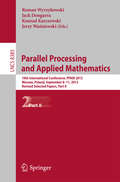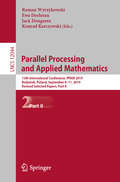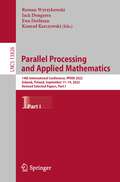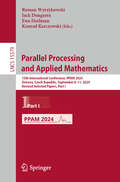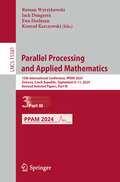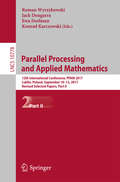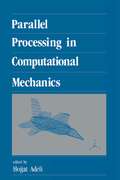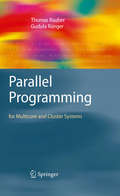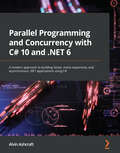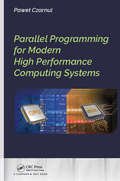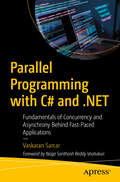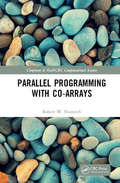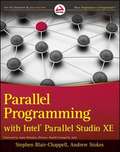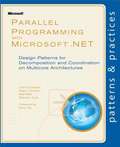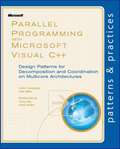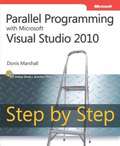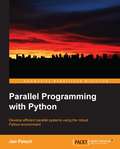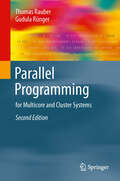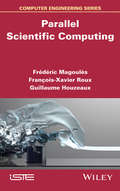- Table View
- List View
Parallel Processing and Applied Mathematics
by Jerzy Waśniewski Roman Wyrzykowski Jack Dongarra Konrad KarczewskiThis two-volume-set (LNCS 8384 and 8385) constitutes the refereed proceedings of the 10th International Conference of Parallel Processing and Applied Mathematics, PPAM 2013, held in Warsaw, Poland, in September 2013. The 143 revised full papers presented in both volumes were carefully reviewed and selected from numerous submissions. The papers cover important fields of parallel/distributed/cloud computing and applied mathematics, such as numerical algorithms and parallel scientific computing; parallel non-numerical algorithms; tools and environments for parallel/distributed/cloud computing; applications of parallel computing; applied mathematics, evolutionary computing and metaheuristics.
Parallel Processing and Applied Mathematics
by Jerzy Waśniewski Roman Wyrzykowski Jack Dongarra Konrad KarczewskiThis two-volume-set (LNCS 8384 and 8385) constitutes the refereed proceedings of the 10th International Conference of Parallel Processing and Applied Mathematics, PPAM 2013, held in Warsaw, Poland, in September 2013. The 143 revised full papers presented in both volumes were carefully reviewed and selected from numerous submissions. The papers cover important fields of parallel/distributed/cloud computing and applied mathematics, such as numerical algorithms and parallel scientific computing; parallel non-numerical algorithms; tools and environments for parallel/distributed/cloud computing; applications of parallel computing; applied mathematics, evolutionary computing and metaheuristics.
Parallel Processing and Applied Mathematics: 13th International Conference, PPAM 2019, Bialystok, Poland, September 8–11, 2019, Revised Selected Papers, Part I (Lecture Notes in Computer Science #12043)
by Roman Wyrzykowski Ewa Deelman Jack Dongarra Konrad KarczewskiThe two-volume set LNCS 12043 and 12044 constitutes revised selected papers from the 13th International Conference on Parallel Processing and Applied Mathematics, PPAM 2019, held in Bialystok, Poland, in September 2019.The 91 regular papers presented in these volumes were selected from 161 submissions. For regular tracks of the conference, 41 papers were selected from 89 submissions. The papers were organized in topical sections named as follows: Part I: numerical algorithms and parallel scientific computing; emerging HPC architectures; performance analysis and scheduling in HPC systems; environments and frameworks for parallel/distributed/cloud computing; applications of parallel computing; parallel non-numerical algorithms; soft computing with applications; special session on GPU computing; special session on parallel matrix factorizations. Part II: workshop on language-based parallel programming models (WLPP 2019); workshop on models algorithms and methodologies for hybrid parallelism in new HPC systems; workshop on power and energy aspects of computations (PEAC 2019); special session on tools for energy efficient computing; workshop on scheduling for parallel computing (SPC 2019); workshop on applied high performance numerical algorithms for PDEs; minisymposium on HPC applications in physical sciences; minisymposium on high performance computing interval methods; workshop on complex collective systems. Chapters "Parallel Adaptive Cross Approximation for the Multi-trace Formulation of Scattering Problems" and "A High-Order Discontinuous Galerkin Solver with Dynamic Adaptive Mesh Refinement to Simulate Cloud Formation Processes" are available open access under a Creative Commons Attribution 4.0 International License via link.springer.com.
Parallel Processing and Applied Mathematics: 13th International Conference, PPAM 2019, Bialystok, Poland, September 8–11, 2019, Revised Selected Papers, Part II (Lecture Notes in Computer Science #12044)
by Roman Wyrzykowski Ewa Deelman Jack Dongarra Konrad KarczewskiThe two-volume set LNCS 12043 and 12044 constitutes revised selected papers from the 13th International Conference on Parallel Processing and Applied Mathematics, PPAM 2019, held in Bialystok, Poland, in September 2019.The 91 regular papers presented in these volumes were selected from 161 submissions. For regular tracks of the conference, 41 papers were selected from 89 submissions. The papers were organized in topical sections named as follows: Part I: numerical algorithms and parallel scientific computing; emerging HPC architectures; performance analysis and scheduling in HPC systems; environments and frameworks for parallel/distributed/cloud computing; applications of parallel computing; parallel non-numerical algorithms; soft computing with applications; special session on GPU computing; special session on parallel matrix factorizations. Part II: workshop on language-based parallel programming models (WLPP 2019); workshop on models algorithms and methodologies for hybrid parallelism in new HPC systems; workshop on power and energy aspects of computations (PEAC 2019); special session on tools for energy efficient computing; workshop on scheduling for parallel computing (SPC 2019); workshop on applied high performance numerical algorithms for PDEs; minisymposium on HPC applications in physical sciences; minisymposium on high performance computing interval methods; workshop on complex collective systems. Chapters "Parallel adaptive cross approximation for the multi-trace formulation of scattering problems" and "A High-Order Discontinuous Galerkin Solver with Dynamic Adaptive Mesh Refinement to Simulate Cloud Formation Processes" of LNCS 12043 are available open access under a Creative Commons Attribution 4.0 International License via link.springer.com.
Parallel Processing and Applied Mathematics: 14th International Conference, PPAM 2022, Gdansk, Poland, September 11–14, 2022, Revised Selected Papers, Part I (Lecture Notes in Computer Science #13826)
by Roman Wyrzykowski Ewa Deelman Jack Dongarra Konrad KarczewskiThis two-volume set, LNCS 13826 and LNCS 13827, constitutes the proceedings of the 14th International Conference on Parallel Processing and Applied Mathematics, PPAM 2022, held in Gdansk, Poland, in September 2022.The 77 regular papers presented in these volumes were selected from 132 submissions. For regular tracks of the conference, 33 papers were selected from 62 submissions.The papers were organized in topical sections named as follows:Part I: numerical algorithms and parallel scientific computing; parallel non-numerical algorithms; GPU computing; performance analysis and prediction in HPC systems; scheduling for parallel computing; environments and frameworks for parallel/cloud computing; applications of parallel and distributed computing; soft computing with applications and special session on parallel EVD/SVD and its application in matrix computations.Part II: 9th Workshop on Language-Based Parallel Programming (WLPP 2022); 6th Workshop on Models, Algorithms and Methodologies for Hybrid Parallelism in New HPC Systems (MAMHYP 2022); first workshop on quantum computing and communication; First Workshop on Applications of Machine Learning and Artificial Intelligence in High Performance Computing (WAML 2022); 4th workshop on applied high performance numerical algorithms for PDEs; 5th minisymposium on HPC applications in physical sciences; 8th minisymposium on high performance computing interval methods; 7th workshop on complex collective systems.
Parallel Processing and Applied Mathematics: 14th International Conference, PPAM 2022, Gdansk, Poland, September 11–14, 2022, Revised Selected Papers, Part II (Lecture Notes in Computer Science #13827)
by Roman Wyrzykowski Ewa Deelman Jack Dongarra Konrad KarczewskiThis two-volume set, LNCS 13826 and LNCS 13827, constitutes the proceedings of the 14th International Conference on Parallel Processing and Applied Mathematics, PPAM 2022, held in Gdansk, Poland, in September 2022.The 77 regular papers presented in these volumes were selected from 132 submissions. For regular tracks of the conference, 33 papers were selected from 62 submissions.The papers were organized in topical sections named as follows:Part I: numerical algorithms and parallel scientific computing; parallel non-numerical algorithms; GPU computing; performance analysis and prediction in HPC systems; scheduling for parallel computing; environments and frameworks for parallel/cloud computing; applications of parallel and distributed computing; soft computing with applications and special session on parallel EVD/SVD and its application in matrix computations.Part II: 9th Workshop on Language-Based Parallel Programming (WLPP 2022); 6th Workshop on Models, Algorithms and Methodologies for Hybrid Parallelism in New HPC Systems (MAMHYP 2022); first workshop on quantum computing and communication; First Workshop on Applications of Machine Learning and Artificial Intelligence in High Performance Computing (WAML 2022); 4th workshop on applied high performance numerical algorithms for PDEs; 5th minisymposium on HPC applications in physical sciences; 8th minisymposium on high performance computing interval methods; 7th workshop on complex collective systems.
Parallel Processing and Applied Mathematics: 15th International Conference, PPAM 2024, Ostrava, Czech Republic, September 8–11, 2024, Revised Selected Papers, Part I (Lecture Notes in Computer Science #15579)
by Roman Wyrzykowski Ewa Deelman Jack Dongarra Konrad KarczewskiThis book constitutes the refereed proceedings of the 15th International Conference on Parallel Processing and Applied Mathematics, PPAM 2024, held in Ostrava, Czech Republic, during September 8–11, 2024. The 75 full papers included in this book were carefully reviewed and selected from 134 submissions. . The papers are organized in the following topical sections: Part I : Numerical Algorithms and Parallel Scientific Computing; Architectural Aspects of HPC; Parallel Non-numerical Algorithms; GPU Computing; Performance Analysis and Prediction in HPCSystems; Environments and Frameworks for Parallel/Cloud/Edge Computing; and Applications of Parallel and Distributed Computing. Part II : First PPAM Workshop on RISC-V (RISC-V PPAM 2024); Special Session on Scheduling for Parallel Computing; 10th Workshop on Language-Based Parallel Programming (WLPP 2024); 7th Workshop on Models Algorithms and Methodologies for Hybrid Parallelism in New HPC Systems (MAMHYP 2024); and Second Workshop on Quantum Computing and Communication. Part III : First Workshop on Advancements of Global Challenges Application; Second Workshop on Applications of Machine Learning and Artificial Intelligence in High Performance Computing; 5th Workshop on Applied High Performance Numerical Algorithms for PDEs; Special Session on Parallel EVD/SVD and its Application in Matrix Computations; 6th Minisymposium on HPC Applications in Physical Sciences; and 8th Workshop on Complex Collective Systems.
Parallel Processing and Applied Mathematics: 15th International Conference, PPAM 2024, Ostrava, Czech Republic, September 8–11, 2024, Revised Selected Papers, Part II (Lecture Notes in Computer Science #15580)
by Roman Wyrzykowski Ewa Deelman Jack Dongarra Konrad KarczewskiThis book constitutes the refereed proceedings of the 15th International Conference on Parallel Processing and Applied Mathematics, PPAM 2024, held in Ostrava, Czech Republic, during September 8–11, 2024. The 75 full papers included in this book were carefully reviewed and selected from 134 submissions. . The papers are organized in the following topical sections: Part I : Numerical Algorithms and Parallel Scientific Computing; Architectural Aspects of HPC; Parallel Non-numerical Algorithms; GPU Computing; Performance Analysis and Prediction in HPCSystems; Environments and Frameworks for Parallel/Cloud/Edge Computing; and Applications of Parallel and Distributed Computing. Part II : First PPAM Workshop on RISC-V (RISC-V PPAM 2024); Special Session on Scheduling for Parallel Computing; 10th Workshop on Language-Based Parallel Programming (WLPP 2024); 7th Workshop on Models Algorithms and Methodologies for Hybrid Parallelism in New HPC Systems (MAMHYP 2024); and Second Workshop on Quantum Computing and Communication. Part III : First Workshop on Advancements of Global Challenges Application; Second Workshop on Applications of Machine Learning and Artificial Intelligence in High Performance Computing; 5th Workshop on Applied High Performance Numerical Algorithms for PDEs; Special Session on Parallel EVD/SVD and its Application in Matrix Computations; 6th Minisymposium on HPC Applications in PhysicalSciences; and 8th Workshop on Complex Collective Systems.
Parallel Processing and Applied Mathematics: 15th International Conference, PPAM 2024, Ostrava, Czech Republic, September 8–11, 2024, Revised Selected Papers, Part III (Lecture Notes in Computer Science #15581)
by Roman Wyrzykowski Ewa Deelman Jack Dongarra Konrad KarczewskiThis book constitutes the refereed proceedings of the 15th International Conference on Parallel Processing and Applied Mathematics, PPAM 2024, held in Ostrava, Czech Republic, during September 8–11, 2024. The 75 full papers included in this book were carefully reviewed and selected from 134 submissions. . The papers are organized in the following topical sections: Part I : Numerical Algorithms and Parallel Scientific Computing; Architectural Aspects of HPC; Parallel Non-numerical Algorithms; GPU Computing; Performance Analysis and Prediction in HPCSystems; Environments and Frameworks for Parallel/Cloud/Edge Computing; and Applications of Parallel and Distributed Computing. Part II : First PPAM Workshop on RISC-V (RISC-V PPAM 2024); Special Session on Scheduling for Parallel Computing; 10th Workshop on Language-Based Parallel Programming (WLPP 2024); 7th Workshop on Models Algorithms and Methodologies for Hybrid Parallelism in New HPC Systems (MAMHYP 2024); and Second Workshop on Quantum Computing and Communication. Part III : First Workshop on Advancements of Global Challenges Application; Second Workshop on Applications of Machine Learning and Artificial Intelligence in High Performance Computing; 5th Workshop on Applied High Performance Numerical Algorithms for PDEs; Special Session on Parallel EVD/SVD and its Application in Matrix Computations; 6th Minisymposium on HPC Applications in PhysicalSciences; and 8th Workshop on Complex Collective Systems.
Parallel Processing and Applied Mathematics: 4th International Conference, Ppam 2001, Naleczow, Poland, September 9-12, 2001, Revised Papers (Lecture Notes in Computer Science #2328)
by Roman Wyrzykowski Ewa Deelman Jack Dongarra Konrad KarczewskiThe two-volume set LNCS 10777 and 10778 constitutes revised selected papers from the 12th International Conference on Parallel Processing and Applied Mathematics, PPAM 2017, held in Lublin, Poland, in September 2017.The 49 regular papers presented in the proceedings were selected from 98 submissions. For the workshops and special sessions, that were held as integral parts of the PPAM 2017 conference, a total of 51 papers was accepted from 75 submissions. The papers were organized in topical sections named as follows:Part I: numerical algorithms and parallel scientific computing; particle methods in simulations; task-based paradigm of parallel computing; GPU computing; parallel non-numerical algorithms; performance evaluation of parallel algorithms and applications; environments and frameworks for parallel/distributed/cloud computing; applications of parallel computing; soft computing with applications; and special session on parallel matrix factorizations.Part II: workshop on models, algorithms and methodologies for hybrid parallelism in new HPC systems; workshop power and energy aspects of computations (PEAC 2017); workshop on scheduling for parallel computing (SPC 2017); workshop on language-based parallel programming models (WLPP 2017); workshop on PGAS programming; minisymposium on HPC applications in physical sciences; minisymposium on high performance computing interval methods; workshop on complex collective systems.
Parallel Processing and Applied Mathematics: 4th International Conference, Ppam 2001, Naleczow, Poland, September 9-12, 2001, Revised Papers (Lecture Notes in Computer Science #2328)
by Roman Wyrzykowski Ewa Deelman Jack Dongarra Konrad KarczewskiThe two-volume set LNCS 10777 and 10778 constitutes revised selected papers from the 12th International Conference on Parallel Processing and Applied Mathematics, PPAM 2017, held in Lublin, Poland, in September 2017.The 49 regular papers presented in this volume were selected from 98 submissions. For the workshops and special sessions, that were held as integral parts of the PPAM 2017 conference, a total of 51 papers was accepted from 75 submissions. The papers were organized in topical sections named as follows:Part I: numerical algorithms and parallel scientific computing; particle methods in simulations; task-based paradigm of parallel computing; GPU computing; parallel non-numerical algorithms; performance evaluation of parallel algorithms and applications; environments and frameworks for parallel/distributed/cloud computing; applications of parallel computing; soft computing with applications; and special session on parallel matrix factorizations. Part II: workshop on models, algorithms and methodologies for hybrid parallelism in new HPC systems; workshop power and energy aspects of computations (PEAC 2017); workshop on scheduling for parallel computing (SPC 2017); workshop on language-based parallel programming models (WLPP 2017); workshop on PGAS programming; minisymposium on HPC applications in physical sciences; minisymposium on high performance computing interval methods; workshop on complex collective systems.
Parallel Processing in Computational Mechanics (New Generation Computing Ser. #2)
by Hojjat AdeliIntroduces mechanical engineers to high-performance computing using the new generation of computers with vector and parallel processing capabilities that allow the solution to problems beyond the ken of traditional computers. The chapters present an introduction and overview, explain several methodo
Parallel Programming
by Thomas Rauber Gudula RüngerInnovations in hardware architecture, like hyper-threading or multicore processors, mean that parallel computing resources are available for inexpensive desktop computers. In only a few years, many standard software products will be based on concepts of parallel programming implemented on such hardware, and the range of applications will be much broader than that of scientific computing, up to now the main application area for parallel computing. Rauber and Rünger take up these recent developments in processor architecture by giving detailed descriptions of parallel programming techniques that are necessary for developing efficient programs for multicore processors as well as for parallel cluster systems and supercomputers. Their book is structured in three main parts, covering all areas of parallel computing: the architecture of parallel systems, parallel programming models and environments, and the implementation of efficient application algorithms. The emphasis lies on parallel programming techniques needed for different architectures. The main goal of the book is to present parallel programming techniques that can be used in many situations for many application areas and which enable the reader to develop correct and efficient parallel programs. Many examples and exercises are provided to show how to apply the techniques. The book can be used as both a textbook for students and a reference book for professionals. The presented material has been used for courses in parallel programming at different universities for many years.
Parallel Programming and Concurrency with C# 10 and .NET 6: A modern approach to building faster, more responsive, and asynchronous .NET applications using C#
by Alvin AshcraftLeverage the latest parallel and concurrency features in .NET 6 when building your next application and explore the benefits and challenges of asynchrony, parallelism, and concurrency in .NET via practical examplesKey FeaturesLearn to implement parallel programming and handle concurrency in .NET efficientlySwitch threads while debugging and learn how to monitor specific threads in Visual StudioDiscover how to cancel tasks with callbacks, by polling, or by using a task with wait handlesBook Description.NET has included managed threading capabilities since the beginning, but early techniques had inherent risks: memory leaks, thread synchronization issues, and deadlocks. This book will help you avoid those pitfalls and leverage the modern constructs available in .NET 6 and C# 10, while providing recommendations on patterns and best practices for parallelism and concurrency. Parallel, concurrent, and asynchronous programming are part of every .NET application today, and it becomes imperative for modern developers to understand how to effectively use these techniques.This book will teach intermediate-level .NET developers how to make their applications faster and more responsive with parallel programming and concurrency in .NET and C# with practical examples. The book starts with the essentials of multi-threaded .NET development and explores how the language and framework constructs have evolved along with .NET. You will later get to grips with the different options available today in .NET 6, followed by insights into best practices, debugging, and unit testing.By the end of this book, you will have a deep understanding of why, when, and how to employ parallelism and concurrency in any .NET application.What you will learnPrevent deadlocks and race conditions with managed threadingUpdate Windows app UIs without causing exceptionsExplore best practices for introducing asynchronous constructs to existing codeAvoid pitfalls when introducing parallelism to your codeImplement the producer-consumer pattern with Dataflow blocksEnforce data sorting when processing data in parallel and safely merge data from multiple sourcesUse concurrent collections that help synchronize data across threadsDebug an everyday parallel app with the Parallel Stacks and Parallel Tasks windowsWho this book is forThis book is for beginner to intermediate-level .NET developers who want to employ the latest parallel and concurrency features in .NET when building their applications. Readers should have a solid understanding of the C# language and any version of the .NET Framework or .NET Core.
Parallel Programming for Modern High Performance Computing Systems
by Pawel CzarnulIn view of the growing presence and popularity of multicore and manycore processors, accelerators, and coprocessors, as well as clusters using such computing devices, the development of efficient parallel applications has become a key challenge to be able to exploit the performance of such systems. This book covers the scope of parallel programming for modern high performance computing systems. It first discusses selected and popular state-of-the-art computing devices and systems available today, These include multicore CPUs, manycore (co)processors, such as Intel Xeon Phi, accelerators, such as GPUs, and clusters, as well as programming models supported on these platforms. It next introduces parallelization through important programming paradigms, such as master-slave, geometric Single Program Multiple Data (SPMD) and divide-and-conquer. The practical and useful elements of the most popular and important APIs for programming parallel HPC systems are discussed, including MPI, OpenMP, Pthreads, CUDA, OpenCL, and OpenACC. It also demonstrates, through selected code listings, how selected APIs can be used to implement important programming paradigms. Furthermore, it shows how the codes can be compiled and executed in a Linux environment. The book also presents hybrid codes that integrate selected APIs for potentially multi-level parallelization and utilization of heterogeneous resources, and it shows how to use modern elements of these APIs. Selected optimization techniques are also included, such as overlapping communication and computations implemented using various APIs. Features: Discusses the popular and currently available computing devices and cluster systems Includes typical paradigms used in parallel programs Explores popular APIs for programming parallel applications Provides code templates that can be used for implementation of paradigms Provides hybrid code examples allowing multi-level parallelization Covers the optimization of parallel programs
Parallel Programming with C# and .NET: Fundamentals of Concurrency and Asynchrony Behind Fast-Paced Applications
by Vaskaran SarcarIf you need to understand concurrency, this book is your guide to the fundamentals behind the advanced software you seek to implement to achieve highly responsive and scalable code. Support for parallel computation is an essential part of concurrency. Concurrency is an advanced concept and solutions are not straightforward. Many developers have been burned by it and are still being burned by it. This book aims to simplify the concept for C# developers. It tries to simplify the concept using the Task Parallel Library (TPL), Concurrent Collections, Parallel LINQ (PLINQ), Asynchronous Programming Patterns, and related topics. The book starts with an overview of TPL and discusses Tasks. Understanding these areas is necessary to learn the concepts that follow in the book. You will go through special scenarios, such as handling exceptions and cancellations, followed by demonstrations of synchronization techniques and concurrent collections. You will see demonstrations of parallel loops to speed up the computations. And you'll understand PLINQ in detail. Finally, you'll learn how to simplify asynchronous programming with async and await keywords is discussed. The book contains “Q&A sessions”, review questions, and exercises (in .NET 8 and C#12). After reading the book, you will be able to understand advanced concepts in parallel programming and implement them in your code. What You Will Learn Understand concurrent and multi-threaded development Understand how some modern-day C# features can promote parallel programming Demonstrate the latest patterns for parallel development Who This Book Is For Developers familiar with C# but are absolute beginners for parallel programming.
Parallel Programming with Co-arrays (Chapman & Hall/CRC Computational Science)
by Robert NumrichParallel Programming with Co-Arrays describes the basic techniques used to design parallel algorithms for high-performance, scientific computing. It is intended for upper-level undergraduate students and graduate students who need to develop parallel codes with little or no previous introduction to parallel computing. It is also intended as a reference manual for researchers active in the field of scientific computing. All the algorithms in the book are based on partition operators. These operators provide a unifying principle that fits seemingly disparate techniques into an overall framework for algorithm design. The book uses the co-array programming model to illustrate how to write code for concrete examples, but it emphasizes that the important concepts for algorithm design are independent of the programming model. With these concepts in mind, the reader can write algorithms in different programming models based on personal taste and comfort.
Parallel Programming with Intel Parallel Studio XE
by Stephen Blair-Chappell Andrew StokesOptimize code for multi-core processors with Intel's Parallel Studio Parallel programming is rapidly becoming a "must-know" skill for developers. Yet, where to start? This teach-yourself tutorial is an ideal starting point for developers who already know Windows C and C++ and are eager to add parallelism to their code. With a focus on applying tools, techniques, and language extensions to implement parallelism, this essential resource teaches you how to write programs for multicore and leverage the power of multicore in your programs. Sharing hands-on case studies and real-world examples, the authors examine the challenges of each project and show you how to overcome them. Explores conversion of serial code to parallel Focuses on implementing Intel Parallel Studio Highlights the benefits of using parallel code Addresses error and performance optimization of code Includes real-world scenarios that illustrate the techniques of advanced parallel programming situations Parallel Programming with Intel Parallel Studio dispels any concerns of difficulty and gets you started creating faster code with Intel Parallel Studio.
Parallel Programming with Microsoft® .NET
by Ralph Johnson Colin Campbell Ade Miller Stephen ToubThe CPU meter shows the problem. One core is running at 100 percent, but all the other cores are idle. Your application is CPU-bound, but you are using only a fraction of the computing power of your multicore system. What next? The answer, in a nutshell, is parallel programming. Where you once would have written the kind of sequential code that is familiar to all programmers, you now find that this no longer meets your performance goals. To use your system's CPU resources efficiently, you need to split your application into pieces that can run at the same time. This is easier said than done. Parallel programming has a reputation for being the domain of experts and a minefield of subtle, hard-to-reproduce software defects. Everyone seems to have a favorite story about a parallel program that did not behave as expected because of a mysterious bug. These stories should inspire a healthy respect for the difficulty of the problems you face in writing your own parallel programs. Fortunately, help has arrived. Microsoft Visual Studio® 2010 introduces a new programming model for parallelism that significantly simplifies the job. Behind the scenes are supporting libraries with sophisticated algorithms that dynamically distribute computations on multicore architectures. Proven design patterns are another source of help. A Guide to Parallel Programming introduces you to the most important and frequently used patterns of parallel programming and gives executable code samples for them, using the Task Parallel Library (TPL) and Parallel LINQ (PLINQ).
Parallel Programming with Microsoft® Visual C++®
by Colin Campbell Ade MillerYour CPU meter shows a problem. One core is running at 100 percent, but all the other cores are idle. Your application is CPU-bound, but you are using only a fraction of the computing power of your multicore system. Is there a way to get better performance? The answer, in a nutshell, is parallel programming. Where you once would have written the kind of sequential code that is familiar to all programmers, you now find that this no longer meets your performance goals. To use your system's CPU resources efficiently, you need to split your application into pieces that can run at the same time. Of course, this is easier said than done. Parallel programming has a reputation for being the domain of experts and a minefield of subtle, hard-to-reproduce software defects. Everyone seems to have a favorite story about a parallel program that did not behave as expected because of a mysterious bug. These stories should inspire a healthy respect for the difficulty of the problems you will face in writing your own parallel programs. Fortunately, help has arrived. The Parallel Patterns Library (PPL) and the Asynchronous Agents Library introduce a new programming model for parallelism that significantly simplifies the job. Behind the scenes are sophisticated algorithms that dynamically distribute computations on multicore architectures. In addition, Microsoft® Visual Studio® 2010 development system includes debugging and analysis tools to support the new parallel programming model. Proven design patterns are another source of help. This guide introduces you to the most important and frequently used patterns of parallel programming and provides executable code samples for them, using PPL. When thinking about where to begin, a good place to start is to review the patterns in this book. See if your problem has any attributes that match the six patterns presented in the following chapters. If it does, delve more deeply into the relevant pattern or patterns and study the sample code.
Parallel Programming with Microsoft® Visual Studio® 2010 Step by Step
by Donis MarshallYour hands-on, step-by-step guide to the fundamentals of parallel programming Teach yourself how to help improve application performance by using parallel programming techniques in Visual Studio 2010--one step at a time. Ideal for experienced programmers with little or no parallel programming experience, this tutorial provides practical, learn-by-doing exercises for creating applications that optimize the use of multicore processors. Discover how to: Apply techniques to help increase your application's speed and efficiency Simplify the process of adding parallelism with the Task Parallel Library (TPL) Execute several tasks concurrently with various scheduling techniques Perform data queries in parallel with PLINQ Use concurrent collections in Microsoft .NET Framework 4 for data items Extend classes in the TPL to meet the specific requirements of your application Perform live debugging of an application with parallel code
Parallel Programming with Python
by Jan PalachA fast, easy-to-follow and clear tutorial to help you develop Parallel computing systems using Python. Along with explaining the fundamentals, the book will also introduce you to slightly advanced concepts and will help you in implementing these techniques in the real world. If you are an experienced Python programmer and are willing to utilize the available computing resources by parallelizing applications in a simple way, then this book is for you. You are required to have a basic knowledge of Python development to get the most of this book.
Parallel Programming: for Multicore and Cluster Systems
by Thomas Rauber Gudula RüngerInnovations in hardware architecture, like hyper-threading or multicore processors, mean that parallel computing resources are available for inexpensive desktop computers. In only a few years, many standard software products will be based on concepts of parallel programming implemented on such hardware, and the range of applications will be much broader than that of scientific computing, up to now the main application area for parallel computing. Rauber and Rünger take up these recent developments in processor architecture by giving detailed descriptions of parallel programming techniques that are necessary for developing efficient programs for multicore processors as well as for parallel cluster systems and supercomputers. Their book is structured in three main parts, covering all areas of parallel computing: the architecture of parallel systems, parallel programming models and environments, and the implementation of efficient application algorithms. The emphasis lies on parallel programming techniques needed for different architectures. For this second edition, all chapters have been carefully revised. The chapter on architecture of parallel systems has been updated considerably, with a greater emphasis on the architecture of multicore systems and adding new material on the latest developments in computer architecture. Lastly, a completely new chapter on general-purpose GPUs and the corresponding programming techniques has been added. The main goal of the book is to present parallel programming techniques that can be used in many situations for a broad range of application areas and which enable the reader to develop correct and efficient parallel programs. Many examples and exercises are provided to show how to apply the techniques. The book can be used as both a textbook for students and a reference book for professionals. The material presented has been used for courses in parallel programming at different universities for many years.
Parallel R: Data Analysis in the Distributed World
by Stephen Weston Q. Ethan McCallumIt’s tough to argue with R as a high-quality, cross-platform, open source statistical software product—unless you’re in the business of crunching Big Data. This concise book introduces you to several strategies for using R to analyze large datasets, including three chapters on using R and Hadoop together. You’ll learn the basics of Snow, Multicore, Parallel, Segue, RHIPE, and Hadoop Streaming, including how to find them, how to use them, when they work well, and when they don’t.With these packages, you can overcome R’s single-threaded nature by spreading work across multiple CPUs, or offloading work to multiple machines to address R’s memory barrier.Snow: works well in a traditional cluster environmentMulticore: popular for multiprocessor and multicore computersParallel: part of the upcoming R 2.14.0 releaseR+Hadoop: provides low-level access to a popular form of cluster computingRHIPE: uses Hadoop’s power with R’s language and interactive shellSegue: lets you use Elastic MapReduce as a backend for lapply-style operations
Parallel Scientific Computing
by Guillaume Houzeaux François-Xavier Roux Frédéric MagoulesScientific computing has become an indispensable tool in numerous fields, such as physics, mechanics, biology,finance and industry. For example, it enables us, thanks to efficient algorithms adapted to current computers, tosimulate, without the help of models or experimentations, the deflection of beams in bending, the sound level in a theater room or a fluid flowing around an aircraft wing.This book presents the scientific computing techniques applied to parallel computing for the numerical simulation of large-scale problems; these problems result from systems modeled by partial differential equations. Computing concepts will be tackled via examples.Implementation and programming techniques resulting from the finite element method will be presented for direct solvers, iterative solvers and domain decomposition methods, along with an introduction to MPI and OpenMP.
